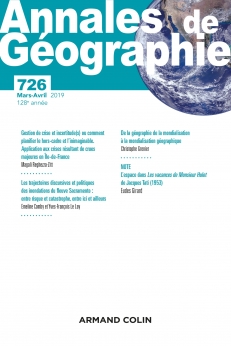
ANNALES DE GÉOGRAPHIE - n°726 (2/2019)
Pour acheter ce numéro, contactez-nous
Recevez les numéros de l'année en cours et accédez à l'intégralité des articles en ligne.
Cet article commence par exposer quelques points de divergence avec des textes fondateurs de géographes français sur la mondialisation, en particulier sur la nature, la durée et la périodisation de celle-ci. À partir d’une définition de la mondialisationcommeprocessusgéohistoriquedontlamodernitéetlecapitalisme sont les principaux agents, on défend la thèse, contraire à celle de la plupart des géographies de la mondialisation, d’une homogénéisation du Monde malgré son inégalité croissante. Cette thèse s’appuie sur une notion dont la présentation est l’objectif principal de l’article, celle de « mondialisation géographique » des diverses régions de la Terre. Leur connexion au système Monde et la diffusion de géographies modernes au cours des périodes historiques du processus de mondialisation se traduisent en effet par une érosion de la diversité géographique ou de la « géodiversité ». Ces notions sont illustrées, dans la dernière partie, par une brève description des quatre périodes de la mondialisation géographique, du XVe siècle à aujourd’hui.
This paper begins by the statement of some points of divergence with founding textsby French geographerson globalization, particularly about the nature, length and periodization of this process. Starting from a definition of globalization as a geohistorical process, with modernity and capitalism as its main agents, the Author supports a notion going against most of these geographies of globalization. The paper proposes the thesis of the World’s homogenization, proceeding in spite of its growing economic inequality. This argument is founded on two notions, the main objective of this paper : the « geographic opening » and « geographic globalization » of the various regions of the Earth. Their connection to the World System and the diffusion of modern geographies during the historical periods of the globalization process entail an erosion of Earth’s diversity or « geodiversity ». Examples of these notions are given in the last part of this paper through a short description of the four periods of the geographic globalization, from the XVth century to the present. The conclusion sets out the question of the Earth as ecumene threatened by globalization.

